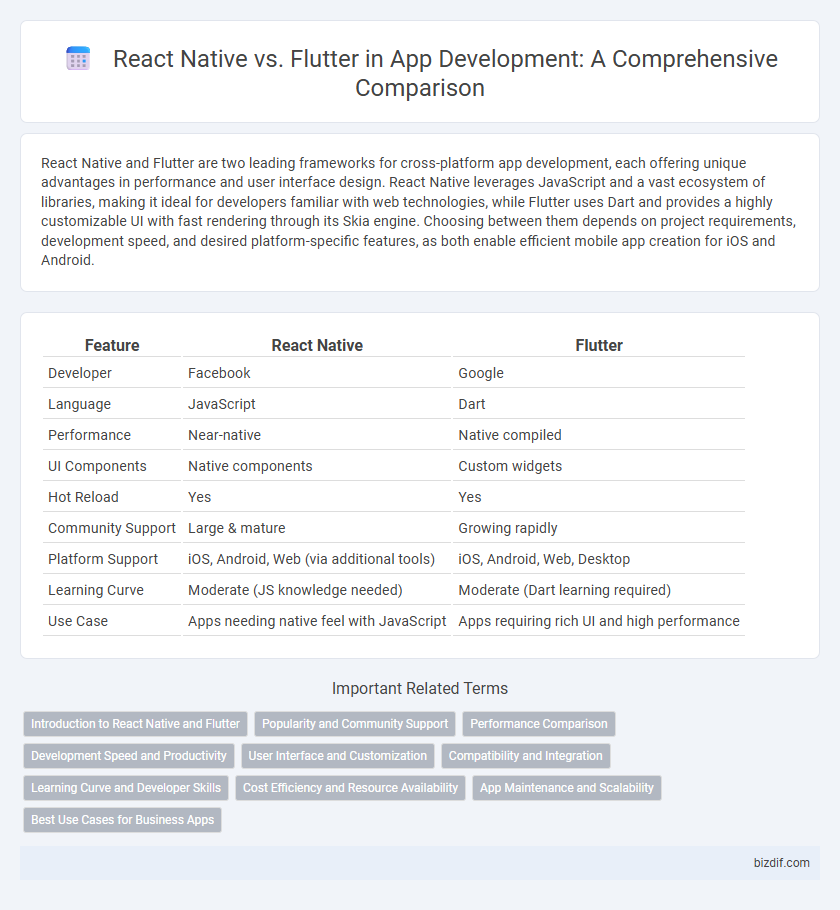React Native and Flutter are two leading frameworks for cross-platform app development, each offering unique advantages in performance and user interface design. React Native leverages JavaScript and a vast ecosystem of libraries, making it ideal for developers familiar with web technologies, while Flutter uses Dart and provides a highly customizable UI with fast rendering through its Skia engine. Choosing between them depends on project requirements, development speed, and desired platform-specific features, as both enable efficient mobile app creation for iOS and Android.
Table of Comparison
| Feature | React Native | Flutter |
|---|---|---|
| Developer | ||
| Language | JavaScript | Dart |
| Performance | Near-native | Native compiled |
| UI Components | Native components | Custom widgets |
| Hot Reload | Yes | Yes |
| Community Support | Large & mature | Growing rapidly |
| Platform Support | iOS, Android, Web (via additional tools) | iOS, Android, Web, Desktop |
| Learning Curve | Moderate (JS knowledge needed) | Moderate (Dart learning required) |
| Use Case | Apps needing native feel with JavaScript | Apps requiring rich UI and high performance |
Introduction to React Native and Flutter
React Native, developed by Facebook, enables cross-platform mobile app development using JavaScript and React, delivering near-native performance and a vast ecosystem of libraries. Flutter, created by Google, uses the Dart language and offers a comprehensive framework for building high-performance, visually attractive apps with a widget-based architecture. Both frameworks support rapid development and hot reload, streamlining the coding process for iOS and Android applications.
Popularity and Community Support
React Native boasts a larger community and extensive third-party libraries, benefiting from Facebook's long-term backing and widespread industry adoption since 2015. Flutter, released by Google in 2017, rapidly gained popularity with its expressive UI capabilities and single codebase for multiple platforms, leading to strong growth in developer interest and community contributions. Despite Flutter's rising momentum, React Native remains the preferred choice for many enterprises due to its mature ecosystem and robust support network.
Performance Comparison
React Native leverages native components and JavaScript bridge, resulting in near-native performance but may face lag in complex animations or high-load processes. Flutter uses Dart and compiles directly to native ARM code, providing faster rendering and smoother UI transitions with its Skia graphics engine. Performance benchmarks often show Flutter outperforming React Native in startup time, frame rates, and CPU usage efficiency for high-intensity applications.
Development Speed and Productivity
React Native accelerates development speed by enabling code reuse across iOS and Android platforms with a vast library of pre-built components. Flutter boosts productivity through its hot reload feature, which allows instant UI updates and faster debugging cycles. Both frameworks enhance development efficiency, but Flutter's single codebase and customizable widgets generally provide quicker iteration and prototyping.
User Interface and Customization
React Native leverages native UI components, enabling seamless integration with platform-specific design standards and offering extensive third-party libraries for customization. Flutter uses its own rendering engine to create highly customizable, pixel-perfect interfaces, allowing developers to craft consistent UIs across iOS and Android with a single codebase. Both frameworks support hot reload for rapid UI iteration, but Flutter's widget-based architecture provides more granular control over every pixel, optimizing user interface flexibility.
Compatibility and Integration
React Native offers strong compatibility with existing native codebases, enabling seamless integration with iOS and Android frameworks through JavaScript bridges, which facilitates access to platform-specific APIs and third-party libraries. Flutter uses a single codebase compiled with Dart, providing consistent UI rendering across platforms while integrating well with platform channels for native functionality, although it may require additional setup for complex native library support. Both frameworks support hot reload and extensive plugin ecosystems, but React Native often benefits from a more mature integration with native development tools due to its longer presence in the market.
Learning Curve and Developer Skills
React Native benefits developers already familiar with JavaScript, offering a gentler learning curve due to its reliance on widely used web development skills. Flutter requires mastering Dart, a less common language, which may extend the onboarding time but provides robust control over UI design and performance. Developers with expertise in either ecosystem leverage their skills to expedite app development cycles and optimize cross-platform functionality.
Cost Efficiency and Resource Availability
React Native offers cost efficiency through a large pool of experienced JavaScript developers, reducing hiring expenses and project timelines. Flutter provides resource advantages by enabling a single codebase for both iOS and Android, minimizing development and maintenance costs. Companies prioritize React Native for faster market entry with existing talent, while Flutter is preferred for long-term scalability and uniform UI across platforms.
App Maintenance and Scalability
React Native offers a vast ecosystem and reusable components, simplifying app maintenance through hot reloading and widespread developer support. Flutter provides a robust architecture with a single codebase for both iOS and Android, enhancing scalability and reducing long-term maintenance efforts. Choosing Flutter can lead to faster updates and consistent performance, while React Native benefits from a mature framework and extensive libraries.
Best Use Cases for Business Apps
React Native excels in cross-platform business app development where leveraging a single codebase for iOS and Android accelerates time-to-market and reduces costs. Flutter is ideal for visually-rich, custom UI business applications requiring high performance and consistent design across devices. Businesses targeting rapid deployment with native-like performance benefit from React Native, while those emphasizing brand-centric, animated interfaces prefer Flutter.
React Native vs Flutter Infographic

 bizdif.com
bizdif.com